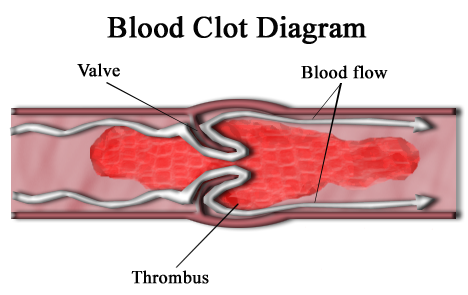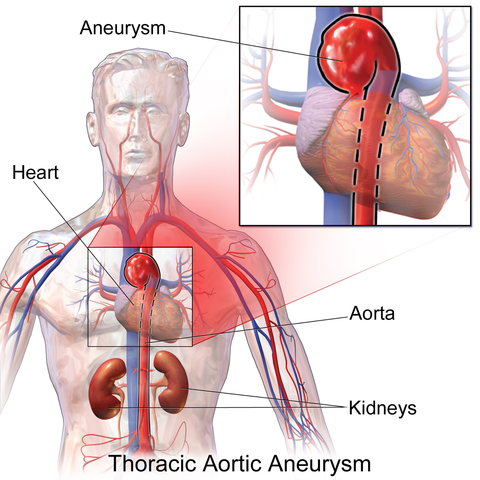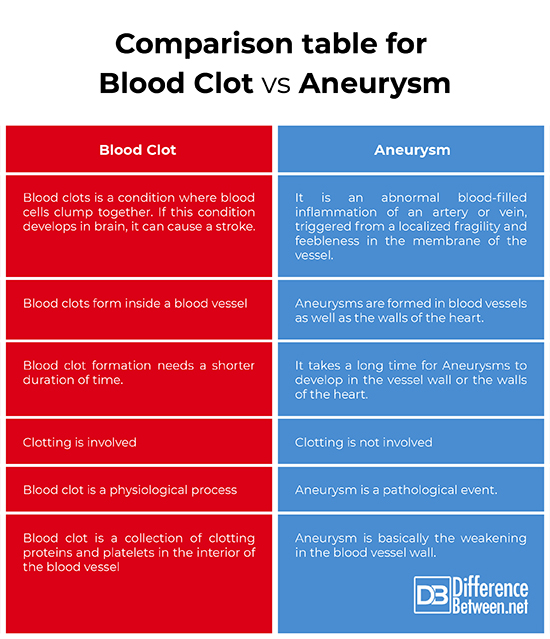Difference Between Blood Clot and Aneurysm
What is Blood Clot and Aneurysm?
Both aneurysms and blood clots are serious medical conditions that require immediate medical intervention. Aneurysm is the abnormally large bulge triggered due to the weakening of the walls of the artery and a blood clot is a clump of blood caused due to the coagulation of the blood.
The major difference between a blood clot and aneurysm is in their location; a blood clot develops in the blood and an aneurysm occurs in a major artery from the heart called the aortic aneurysm. When it occurs in the brain, it is called the cerebral aneurysm.

What is Blood Clot?
Blood clots are a meshwork of sticky blood cells that develop when a blood vessel is destructed. Clotting is a physiological process that is triggered as a normal response to impaired or ruptured blood vessel. The primary function of a blood clot is to seal and prevent the leakage in a ruptured blood vessel. This stops the waste of blood and protects the person from continuous bleeding. Clots (or thrombi) that obstruct the arteries and stop the flow of blood and oxygen to that body organs can cause tissue damage (infarcts). And, when the blood clots disintegrate (known as embolism) and travel to other parts of the body, they can damage other organs. Clots that obstruct the flow of blood are the main culprits in most heart failures and strokes.
What is Aneurysm?
An Aneurysm is known as a bulge in an artery and are also known as the weakened areas of the arteries. They can balloon out or rupture out at any time when the patient is in a serious condition and has the risk of bleeding out. It is a pathological mechanism.
Aneurysm are most commonly seen in the aorta, (the primary artery in the middle of the belly, and the largest artery in the body), the brain, and in the popliteal artery i.e. behind the knee. The 2 major causes of aortic aneurysms are hypertension and atherosclerosis.

Difference between Blood Clot and Aneurysm
-
Definition
Blood Clot
Blood clot is defined as clumped blood platelets or other tiny cells in the body, resulting in clogging up a blood artery or a vein. Blood clots can for anywhere in the blood vessels but is most common in the legs.
Aneurysm
Aneurysm is a permanent, localized and abnormal dilatation of a blood vessel or the wall of the heart, that is a result of the weakening or the destruction of the vessel wall.
-
Symptoms
Blood Clot
- Slurred speech or inability to talk
- Loss of coordination
- Reddish or bluish skin discoloration
- Sudden intense headache
- Weakness in arms or legs
Aneurysm
- Vision problems
- Speaking difficulties
- Weakness in one or both limbs
- Stomach getting upset
- Puking
-
Causes
Blood Clot
Several causes include;
- Pregnancy
- Stroke
- Smoking
- Prolonged lying in one position at one place
- Heart attack
- Certain medications, like oral contraceptives and hormone therapy drugs
- When immune system attacks some of the normal proteins in your blood known as Antiphospholipid syndrome
- Pulmonary embolism (blood clot in an artery in the lung)
Aneurysm
Aneurysm is caused by sudden trauma, an ongoing medical condition like high B.P or even drug abuse, or a vascular disorder that is present since birth. Other factors include atherosclerosis, and abnormal blood flow at the junction at which arteries come together.
-
Prognosis
Blood Clot
The prognosis in case of ischemic stroke is extremely variable and dependant on where the clot develops in the brain, how long will it remain there before treatment takes place and, how much effective the treatment will be. Consequently, such strokes vary in prognosis from good to poor, depending upon the above given conditions and how well the affected individual will respond to the medication, treatment or the rehabilitation. Haemorrhagic strokes more often have a poorer prognosis and possess elevated mortality rate than ischemic strokes.
Aneurysm
The prognosis for brain aneurysms is good as long as they don’t show any leakage or burst open. Some procedures involved have a mortality rate of three percent. If there is a leakage in the brain aneurysm, the prognosis is weak and mortality rate becomes higher unless acute neurosurgical or neuro-interventional treatment is accomplished and successful.
-
Risk factors and prevention
Blood Clot
The major preventable risk elements for a blood clot are;
- Unhealthy and poor diet
- Absence of physical activity
- Obesity
Some factors like genetics is not preventable. However, some factors can be managed well like high blood pressure, obesity and cholesterol.
Aneurysm
The major preventable risk elements for Aneurysm are;
- High blood pressure
- Smoking
Other risk factors that are unpreventable include genetics and age. Prevention includes regular exercising and stop smoking.
-
Treatment
Blood Clot
Blood-thinning medications like warfarin, oral anticoagulants (e.g., dabigatran, rivaroxaban, apixaban), heparins (like enoxaparin, dalteparin, or tinzaparin) and fondaparinux are usually recommended.
Aneurysm
Treatments involve sealing the blood vessel that has ruptured.
The first treatment method is called surgical clipping. In this, a part of the skull is removed to get to the ruptured or damaged blood vessel and a small metal clip is used to prevent the blood from flowing through the rupture.
A less invasive method, is known as the endovascular coiling. This method involves inserting a tube in an artery (mostly accessed in the groin) and intertwining it throughout the body to the aneurysm. After that, a metal coil is pushed in the affected vein, efficaciously sealing the aneurysm.
Summary
The points of difference between Blood Clot and Aneurysm have been summarized below:
Comparison table for Blood Clot Vs. Aneurysm

- Difference Between Vaccination and Immunization - March 3, 2024
- Difference Between Selective Mutism and Autism - February 25, 2024
- Difference Between Depersonalization-Derealization and Dissociation - January 18, 2024
Search DifferenceBetween.net :
 Email This Post
: If you like this article or our site. Please spread the word. Share it with your friends/family.
Email This Post
: If you like this article or our site. Please spread the word. Share it with your friends/family.
2 Comments
Leave a Response
References :
[0]Augsburger, L., Reymond, P., Fonck, E., Kulcsar, Z., Farhat, M., Ohta, M., ... & Rüfenacht, D. A. (2009). Methodologies to assess blood flow in cerebral aneurysms: Current state of research and perspectives. Journal of neuroradiology, 36(5), 270-277.
[1]Johri, P., Nagare, S., Swamy, K. V., & Kumar, C. S. (2011). An insight into blood clotting disorders in humans. Journal of Computational Biology and Bioinformatics Research, 3(1), 8-14.
[2]Karunanithi, K., Lee, C. J., Zhang, Y., & Qian, Y. (2012). RISK STRATIFICATION OF CEREBROVASCULAR ANEURYSMS USING CFD A REVIEW. RISK, 10, 12.
[3]Novitzke, J. (2008). The basics of brain aneurysms: a guide for patients. Journal of vascular and interventional neurology, 1(3), 89.
[4]Image credit: https://upload.wikimedia.org/wikipedia/commons/thumb/4/44/Thoracic_Aortic_Aneurysm.png/480px-Thoracic_Aortic_Aneurysm.png
[5]Image credit: https://upload.wikimedia.org/wikipedia/commons/c/c5/Blood_clot_diagram.png


Thank you. This is my second one in my brain. I needed to understand it. Due to the clear writing, I do understand the aneurysm now. I just wish the VA would do something! Sitting here alone, at home, waiting, is so upsetting. But now I understand things better. Thank you.
Thank you,I’ve had a aneurysm coiled, still having symptoms? This was very informative. Is there a connection between varicose veins and aneurysm/ blood clots ?